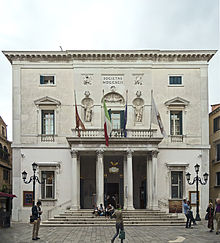
Is there any opera that is talked about (or written about) as often as La Traviata? Who knows? And while La Traviata is not one of the much referred-to three most popular operas in the world (the famous alphabetical A-B-C: Aida, La Bohème, and Carmen), it remains steadfast in the repertory in almost every serious opera house. And in Venice, in particular, it is almost on-going. I don’t know if La Traviata is performed at La Fenice every season, but it seems to me that every time I read about the music season in Venice, this grand opera is on the schedule.
And there’s nothing wrong with that. Verdi’s great work – for which Francesco Maria Piave was the librettist – was premiered at Teatro La Fenice on March 6, 1853 (almost exactly 166 years ago), so it would be entirely appropriate if the opera is performed there every season. And the story behind the composition of the opera itself is of much interest to opera-goers, and the opera is spoken about (and written about) often. In fact, with the Met’s new production – on stage since last fall – there’s much talk in New York about La Traviata. Even a program note for the new production tells us that the opera has been performed at the Metropolitan Opera House more than a thousand times since 1892, with the program note adding yet another astonishing fact: “according to popular lore, for the last one hundred years there has been at least one performance of La Traviata somewhere in the world every single night.”

And as for the title of this post, perhaps I’m taking a little literary license here, for the production of La Fenice’s intriguing La Traviata is, yes, from “our own time.” It is a phrase Robert Carsen uses in his essay about the opera in the La Fenice program book but in his case, his “our own time” refers to 2004, when his new production was introduced. He had been chosen to design the production that would be the first performance to re-open the opera house following the disaster of 1996, as La Fenice had been destroyed by fire on January 29 that year. Sadly enough it was the third time for La Fenice, which, appropriately, is Italian for The Phoenix. The first fire was in 1774 and the second in 1836. Worse yet, the third fire has been described as the result of arson, and when it was finally under control and the fire eventually put out, everything but the exterior walls was gone. Reading about the fire was a heart-breaking experience for opera lovers the world over, and since then, many descriptions have made clear the horror of the 1996 fire. For me, the one that captures the true shock of the event (and the amazing heroism of the Venetian firefighters) is a 5½ minute 2008 documentary from Michele Barca. L’incendio della Fenice (with English subtitles) makes for gripping watching.
I’ve not done research to try to determine why Carsen was chosen for this splendid assignment back in the late 1990s. That doesn’t matter, for from my point of view after witnessing the opera at La Fenice, I’m very thrilled I was able to be there for it. If you read what I wrote about his Mefistofele back in November, or enjoyed his most recent Der Rosenkavalier at the Met (despite setting the final act in an upscale bawdy house instead of an inn), you know I have great respect for Carsen’s work. And I certainly wasn’t disappointed with what he did with Verdi’s great masterpiece for La Fenice’s 2004 opening of its re-built and restored architectural jewel. In La Fenice’s program book, the title of Carsen’s essay is “A Subject from Our Own Time,” a quotation from a letter written by Verdi two months before the opera’s opening. Carsen reports how, as Verdi had put it, “the costumes, the period and a thousand other reservations” presented great difficulties. Verdi had wanted to have the opera staged in modern dress, but this wouldn’t do. The local censors forbade it and the period was set back nearly 200 years. Even more problematic, Alexandre Dumas’ play – used by Verdi as the basis for La Traviata – was being performed in contemporary dress just a few streets away, at the Teatro Apollo in Campo San Luca. Were the censors consistent in their thinking? No way!

So how would I describe the 2004 production at La Fenice, even as it is performed today? Certainly there is a goodly amount of what could be considered “raw” allusions to sexual fun-and-games in some of the costuming, and surely the activities of some of the characters at Flora’s masked ball left a few people wanting to look away, as her ball could easily have been an evening in a rather raucous night club or even a raunchy bordello. But there was also beautiful, perhaps a little higher-class decorum at Violetta’s salon and the costumes – modern, yes (as in 2004), but quite lovely – made it look like a party Alfredo would be drawn to, even if he were not already anxious to make the acquaintance of Violetta.
The performances? Absolutely stunning. Not living in Italy I am not familiar with the singers by name, but I was mightily impressed with the quality of the singing and the acting. Most of the cast, including Conductor Francesco Ivan Ciampa, appeared to me to be mid- to late-thirties or early forties and they brought a tremendous amount of energy to their performances, both musically and as actors. A great pleasure indeed.
Leave a Reply